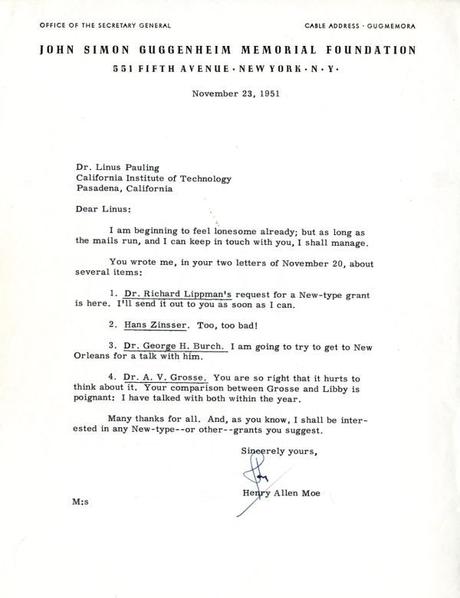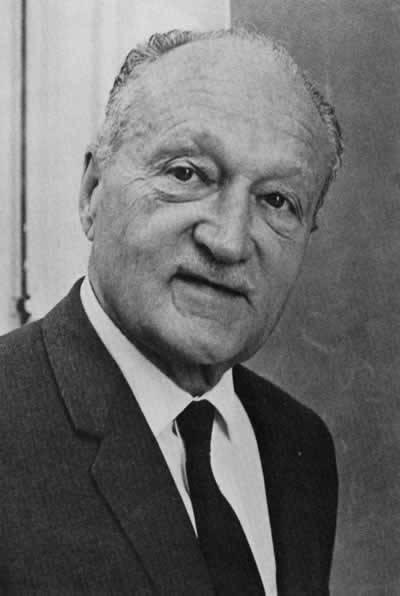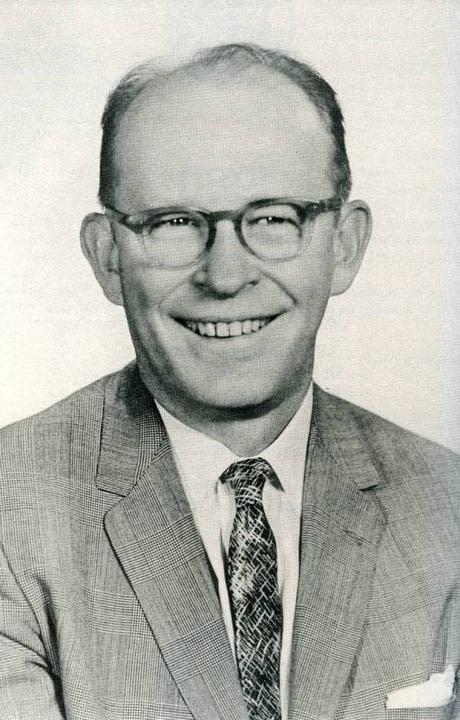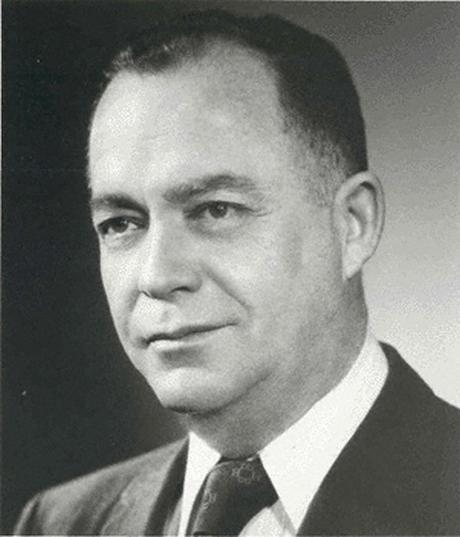 Letter from Henry Allen Moe to Linus Pauling, November 1951
Letter from Henry Allen Moe to Linus Pauling, November 1951[Pauling and the Guggenheim Foundation]
Melvin Newman’s difficulties working under the fellowship conditions stipulated by the John Simon Guggenheim Memorial Foundation – particularly that fellows not be permitted to work separate jobs during their award tenures – prompted the Committee of Selection to begin working out a plan for a new type of fellowship. These revised funding guidelines focused mostly on providing support for established researchers without requiring them to step away from their other duties.
Though Newman’s case ushered in the change, it was not the first time the Foundation had been asked to bend its policies. An earlier applicant, English professor Frederick A. Pottle, had requested that he be allowed to continue teaching at Yale during his fellowship because he could not afford to go elsewhere unless he took out a loan.
Many other applicants surely sympathized with Pottle’s circumstances. For the fellowship’s entire history, awardees were required to take leaves of absence of at least six months, a stipulation that often proved problematic. As professors, scientists, and professionals, fellows routinely had duties assigned to them that they could not ignore, and the Guggenheim’s rules sometimes required them to focus on these duties over unreasonably short periods of time.
Fellows also commonly had material needs connected to advancing their research that a travel scholarship did not cover. For instance, scientists frequently needed instruments, humanists microfilm, and social scientists help with compiling data, while authors of all backgrounds struggled with publication costs. The six month term of absence caused issues as well and it was argued that shorter term fellowships might work better for some, as it would allow them to forgo summer teaching jobs, for example, in favor of research.
In a letter discussing these problems with the Committee of Selection, Henry Allen Moe, the Secretary General of the Foundation, reminded members that the Foundation was chartered
to promote the advancement and diffusion of knowledge and understanding and the appreciation of beauty, by aiding without distinction on account of race, color or creed, scholars, scientists and artists of either sex in the prosecution of their labor.
For Moe, the freedom from restriction built in to the Fellowships had been successful because the Committee of Selection had only picked “high grade people” who were “truly creative scholars and artists” that “would not consider using the money for anything else.”
The new-style fellowships being pondered were seen by Moe as extending that freedom to older scholars who could also benefit from developmental support. Though it would be designated as a fellowship, the new program would fit with the idea of a “grant-in-aid” to assist fellows on the job.
 F.O. Koenig
F.O. KoenigIn September 1949, plans for the new fellowships began to take shape in the form of a trial run. In anticipation, Moe passed along to the Committee of Selection several examples of who might receive the trial fellowships and requested feedback on how much money each might require. Linus Pauling, who was on the Committee, thought the plan a good one and supplied his own list of potential candidates with financial estimates for each.
Several of Pauling’s suggestions were ultimately included in the first batch of new-style fellowships. One of them was M. C. Terry, a retired physician who found a correlation between diabetes and the bitter taste of diphenylthiourea. Pauling supported Terry’s ambition to travel to Jamaica to find out if the correlation was dependent on race.
Another suggestion, Richard W. Lippman, was an unpaid research assistant at the Institute for Medical Research, Cedars of Lebanon Hospital, and the proprietor of a part-time medical practice focusing on renal disease and hypertension. Lippman, who was also Pauling’s personal physician, was working on a book on the interpretation of clinical urine and urine sediment tests, and wanted to include color photographs of the urine sediment since no such images existed in publication. He needed help covering those costs and looked to the Foundation for assistance.
F. O. Koenig already had a fellowship looking at the history of the conservation of energy and the influence of Romantic poets and philosophers on the nomenclature of polarized light. He wished to continue his work by hiring an assistant for clerical and translation work.
 Willard F. Libby
Willard F. LibbyThe trial run went smoothly enough that the Foundation decided to expand the new fellowships the following year. Once again asked for recommendations, Pauling put forth Willard F. Libby, Professor of Chemistry at the University of Chicago, as a strong candidate for the new program. Libby had received a year-long $2,500 Guggenheim award in 1941 to study the applications of nuclear physics to chemistry, but he was called to work on the Manhattan Project shortly thereafter, leaving his fellowship unfinished. Libby’s more recent research focus was on carbon-14 dating.
Moe visited Libby in Chicago and found both his modesty and his skepticism of his own work to be refreshing, given his high profile. Another member of the Advisory Board, geographer Carl Sauer, strongly endorsed Libby’s candidacy as he expected him to have the best chance of finding and fixing crucial problems with carbon-14 dating. Libby was ultimately approved at $10,000 for two years, and in 1960 he was awarded the Nobel Prize in chemistry, specifically for the carbon dating work.
One of Libby’s colleagues was Aristid V. Grosse, a Temple University professor who applied for a fellowship the following year to work on fluorocarbon chemistry. Grosse had received a Guggenheim fellowship in 1940 for studies in nuclear chemistry and biochemistry, but when Moe asked about his potential for the new type of fellowship, Pauling suggested that he had not developed much as a chemist since his previous award. Though Grosse’s work had garnered a good deal of public attention, Pauling felt it to be relatively unimportant, even “trivial.” Pauling also believed that Grosse had taken more credit than was due to him in regards to his collaborations with Libby on carbon-14. Finally, Grosse’s proposed project was, for Pauling, fairly unoriginal and uninteresting.
Despite all of these misgivings, Pauling still considered Grosse to be a contender for the new type of fellowship because of his abilities and his standing as a former fellow. Furthermore, his field was interesting and he requested only a small amount of funding, though Pauling expected that any significant contribution arising from the project would be accidental. In the end Pauling decided not to support him, but expressed a willingness to accept his approval should the rest of the committee regard him as worthy. As it happened, the committee agreed with Pauling and Grosse did not receive a fellowship.
 George Burch
George BurchAnother 1951 candidate for the new type of fellowship was Melville Wolfrom, a chemist at Ohio State University who had just been elected to the National Academy of Sciences. The recipient of a 1939 award, this time around Wolfrom wanted $54,500 per year for two to five years to study carbohydrate chemistry, an amount that was far larger than the sums normally granted. Pauling discussed Wolfram’s case with his Caltech colleague Carl Niemann, who had done some work with carbohydrates. Following this consultation, Pauling offered that Wolfrom was very experimental and hardworking, and had a sound knowledge that placed him as a leader of his field.
Wolfrom’s program, however, struck Pauling as being unoriginal. Pauling also wondered why the Office of Naval Research or the United States Public Health Service was not funding his work, noting that
It has been my opinion that a research project should serve as a satisfactory basis for a new-type fellowship only if it had some unusual character, and that, moreover, support for a research project would not be given in case that it seemed likely that it could be obtained from ordinary sources.
Wolfrom failed Pauling’s criteria on both counts. “There is no large element of chance involved,” he felt, “which might cause the ordinary sources of funds to shy away.” Pauling recommended that no fellowship be given and this guidance was followed.
Towards the end of the year, Pauling suggested that George E. Burch, Professor of Medicine at Tulane University, would be a good candidate for the new type of fellowship, which he would use to hire a research assistant. Burch’s primary knowledge was of the heart, but he was interested in other organs as well.
Pauling had visited Burch’s laboratory in New Orleans and was quite impressed by what he saw. Motivations connected to his own research also played a role in Pauling’s recommendation, as he hoped Burch would run clinical tests on the use of controlled amounts of carbon monoxide in controlling sickle cell anemia, a treatment based on Pauling’s previous findings.
Moe was able to visit Burch in New Orleans and agreed with Pauling’s assessment. He also thought William Love, whom Burch wanted to hire, to be a good candidate for the assistantship. The only thing Moe was uncertain about was whether to give him the $5,000 for one year that he had requested or to extend it to $15,000 over three years.
The new-type fellowships proved to be both successful and popular, and they opened up Guggenheim funding to a large group of researchers who had previously needed to look elsewhere. As we’ll explore in a future blog post, Pauling himself would also benefit from one of these fellowships later on in his career.
